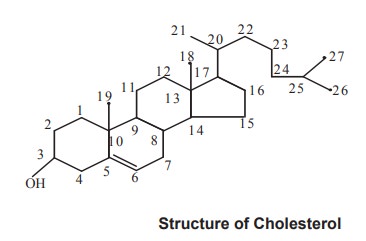Chapter: Biochemistry: Lipid Metabolism
Cholesterol Biosynthesis

Cholesterol Biosynthesis
Cholesterol is an animal sterol which occurs
either free or as fatty esters. As it was first isolated from human gallstones
deposited in the bile duct, it is named as cholesterol (Greek word chole means
– bile, sterol). Cholesterol is composed of
1,2-cyclopentanoperhydrophenanthrene ring system. Although cholesterol is an
essential compound for life for the synthesis of hormones, bile acids and
vitamin D, it is not necessary to supply it in the diet because it can be
synthesised in the cell from acetyl CoA Carbohydrates, amino acids, fatty acids
and glycerol which gets converted to Acetyl CoA can also serve as a source for
cholesterol synthesis. The liver plays a decisive role in the cholesterol
metabolism which accounts for 90% of the overall endogenic cholesterol and its
esters.
A man weighing 70 kg contains about 140 grams of
cholesterol. The cholesterol concentration of blood in human is between 150 to
250 mg per 100 ml, being distributed equally between the cells and the plasma.
The half life of cholesterol is about 8 to 12 days.

1. Biosynthesis of cholesterol
Important intermediates of cholesterol
Biosynthesis and enzymes involved.
1. Formation of acetyl CoA
A molecule of acetic acid combines with coenzyme
A (CoA) to produce Acetyl CoA in the presence of an enzyme Acetyl CoA
synthetase.
2. Formation of acetoacetyl CoA
Two molecules of acetyl-CoA condense to form an
acetoacetyl-CoA molecule, catalyzed by the enzyme “thiolase”.
3. Formation of HMG CoA
The acetoacetyl-CoA further undergoes
condensation with one more molecule of acetyl-CoA to form HMG-CoA (3-Hydroxy
3-Methyl Glutaryl-CoA). The enzyme which mediates this reaction is called
HMG-CoA synthetase.
4. Formation of mevalonate
The HMG-CoA is reduced to form mevalonate by
NADPH + H+ dependent reductase (HMG-CoA reductase). This is the rate limiting
enzyme in the pathway of cholesterol biosynthesis.
5. Mevalonate thus formed is then converted to
squalene through various steps.
6. Squalene, with the formation of various
intermediates finally give rise to the end product cholesterol.

2. Important products derived from cholesterol
In the body cholesterol is converted into
several other types of biologically important steroids, viz. bile acids, bile
salts and Vitamin D.
1. Synthesis of Bile Salts from Bile acids
Bile acids are of two types namely primary and
secondary bile acids. Primary bile acids include cholic acid and chenodeoxy
cholic acid and secondary bile acids include deoxycholic acid and lithocholic
acid.
Importance
Bile acids are C24 steroids,
detergent like compounds that are responsible for the emulsification and
absorption of lipids in the intestine.
Bile salts
Cholic acid is conjugated in the liver with
either glycine or taurine through peptide linkages forming the bile salts
glycocholic acid and taurocholic acid respectively. They combine with sodium
and potassium present in the bile and form water soluble alkaline bile salts,
namely sodium glycocholate and sodium taurocholate respectively.
Importance
·
Bile
salts are the digestion promoting constituents of bile.
·
They
lower surface tension and thus can emulsify fats.
·
They
also activate lipases.
Vitamin D
Vitamin D is produced by irradiation of
7-dehydrocholesterol in the skin and in the kidney.
Importance
Vitamin D is a derivative of cholesterol and the
precursor of para thyroid hormone which regulates calcium and phosphate
metabolism in vertebrates.
Phospholipids
Phospholipids are so designated because they
contain phosphoric acid. They are present in all cells, plants as well as
animals. They are present both in cytoplasm as well as in the cell membranes
and serve important functions in both cell activity and cell permeability.
Phospholipids are made up of fatty acids, nitrogenous base, phosphoric acid and
glycerol or other alcohol. Phospholipids can be classified based on the alcohol
moiety of the phospholipid as follows.
1. Glycerophosphatides
Glycerol is the alcohol moiety in this group.
This include lecithins, cephalins, phosphatidyl serine, plasmalogens and
diphosphatidyl glycerols.
2. Phosphoinositides
In this the cyclic hexahydric alcohol “inositol”
replaces the nitrogenous base.
3. Sphingolipids
In this group of substances, glycerol is
replaced by a complex amino alcohol “Sphingosine”. These are clinically
important phospholipids in human.
Related Topics